
Here at Stikky Media we have a great relationship with the Google Ads team, and one of the perks is that we get calls from the team whenever new features are rolled out. We got one such call when Google AdWords switched over to Google Ads, and as well as getting the rundown on the new Google Ads experience we also received a few great tips that we thought you’d want to know about. Keep in mind a couple of these tips are only available in the new Google Ads interface, so before you read on make sure you’ve switched to the new Google Ads Experience, and if you’re not sure click that link to learn how to tell the difference between the two.
And the top four Google Ads optimization tips for 2018 are (drumroll please):
1. Enable Parallel Tracking
Parallel Tracking might be an unfamiliar term but it’s good to learn about it now as it will be required of all Google Ads accounts come October 30th 2018.
Essentially, Google Ads’ tracking to date has been implemented by loading a Google Ads tracker followed by a tracking URL prior to the end user seeing the landing page. This leads to customers seeing one or more redirects (more depending on if additional tracking is loaded), leading to a longer load time of the actual landing page.
A key benefit of the new parallel tracking is the landing page is loaded right after the ad is clicked, with all the tracking loading in the background – in parallel – to the actual page being loaded. This improves the overall user experience for users clicking on ads as the page load time is quite a bit faster. An improved user experience correlates with better CTR.
How to Enable Parallel Tracking
Google Ads Parallel Tracking is buried pretty deep in the interface but once found is very easy to implement. So if you’re reading this prior to the end of October 2018 you only need to do the following to opt in for each of your accounts:
- In the main navigation column on the left that starts with Overview, click on Settings
- Click on Account Settings in the menu near the top of the screen
- Click Tracking near the top of the page, then click to enable Parallel Tracking
That’s it! If you have more than one Google Ads account you’ll be enabling Parallel Tracking the same way across each account.
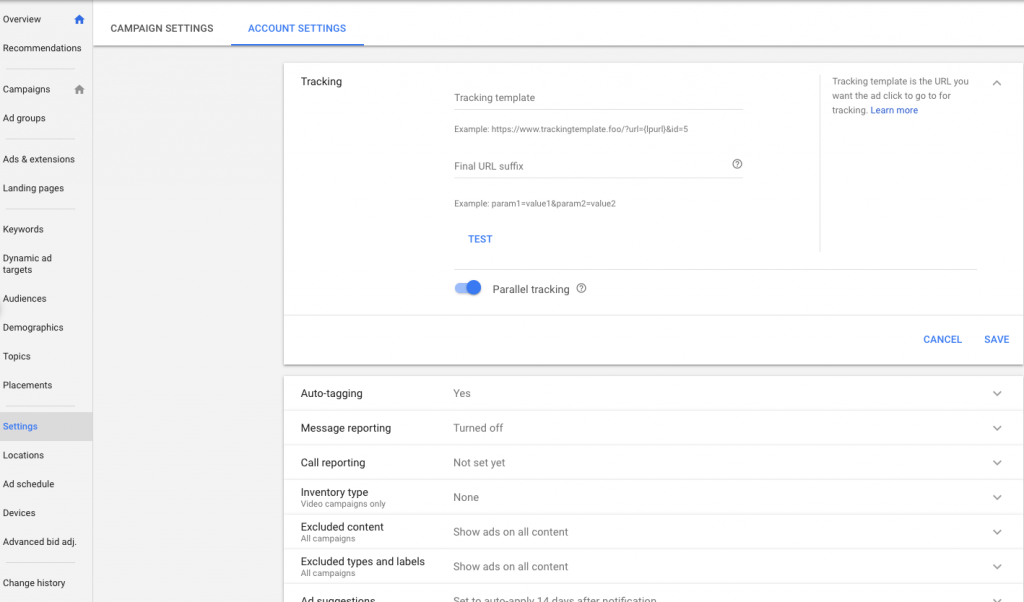
Learn more about Google Ads Parallel Tracking here, or to get some in-depth developer notes on what’s happening behind the scenes click here.
2. Link Google Ads and Google Analytics
If you haven’t already linked Google Analytics and Google Ads now’s the time. Linking the two accounts allows for Google Ads metrics to be imported seamlessly into the Google Analytics interface. However even if you’ve linked the two accounts the flow of data is generally a one-way street: aside from being able to easily import goals from Google Analytics as conversions in Google Ads, there isn’t much of a role for Google Analytics to play in the Google Ads interface. That is, until you import Google Analytics Metrics.
When Google Analytics metrics are imported into Google Ads, we start seeing some familiar website KPIs, such as bounce rate, appearing in our Google Ads reports. While Google Ads provides some excellent reporting out of the box, such as conversion tracking and ad click through rate, without importing Google Analytics metrics there’s a bit of a black box in the Google Ads interface with the actual traffic quality we’re receiving and how users are actually interacting with the site. Linking Google Analytics and Ads will open this black box and enable you to get stronger ROI from each pay-per-click campaign.
How to Import Google Analytics Metrics into Google Ads
So, to link the two accounts, and to import Google Analytics metrics into Google Ads, simply do the following:
- Click on the Tools icon in the Google Ads top nav, then click Linked Accounts
- You’ll see a group of accounts that you can link to Google Ads. Locate the Google Analytics one and click Details
- Scroll down to the Google Analytics view that corresponds to the Google Ads account you’re using, click the pencil icon next to that view to edit it and check off Link and Import Site Metrics so they both turn blue. (Note: if you have a lot of properties in your Google Analytics account you may need to show more rows than the default, which you can do near the bottom of the page).
- Click Save and you’re done
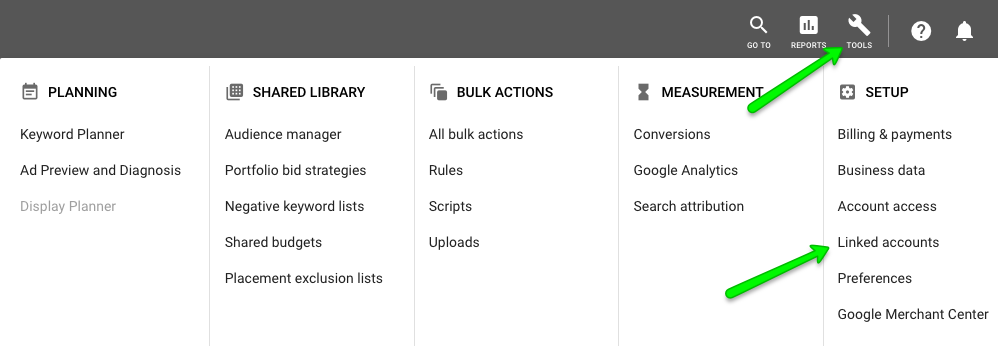
If you haven’t linked these accounts before you’ll now start seeing Google Ads metrics in your Google Analytics account, under Acquisition > Google Ads. And if you haven’t imported site metrics before you can now start enabling those in your reports, as you’ll see in the next tip.
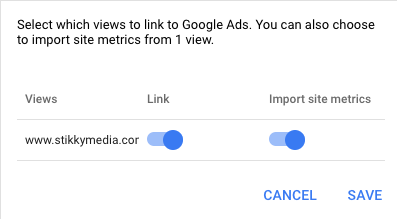
3. Enable Bounce Rate in Google Ads
If you’re importing Google Analytics site metrics into Google Ads you might not be seeing anything different in your reports right off the bat. That’s okay; we actually need to pick a specific metric we want to see in Google Ads and enable it by editing the columns of our reports. If you don’t have experience tweaking your Google Ads reports then this is a great way to get your feet wet.
Why Add Bounce Rate to your Google Ads Reports?
I find one of the most helpful metrics to import into Google Ads is bounce rate, and one of the most relevant reports to add that metric to is the Ads report. This will give you a bit of insight that will help you in split testing your ads and testing your landing pages. For instance, if you have two ads that have similar click through and conversion rates, but one with a substantially lower bounce rate, you’ll know which one to delete and which to keep. As an example, when pausing a high-bounce rate ad and changing the landing page for one client, we saw bounce rate change by -37.5%, meaning bounce rate is now 37.5% lower. Pretty substantial!
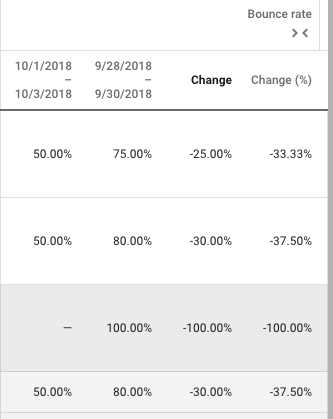
Here’s how to add bounce rate to your Google Ads report:
- Click on Ads and Extensions. You can do this at the account, campaign or ad group level.
- Underneath the graph click Columns, then Modify Columns
- Scroll down and click on Google Analytics, and enable Bounce Rate. (You can also experiment with enabling other KPIs, such as Pages / Session.)
- Click Apply and that’s it

You should now have Bounce Rate added as a column to your Ads report, and can sort your ads by highest/lowest bounce rate.
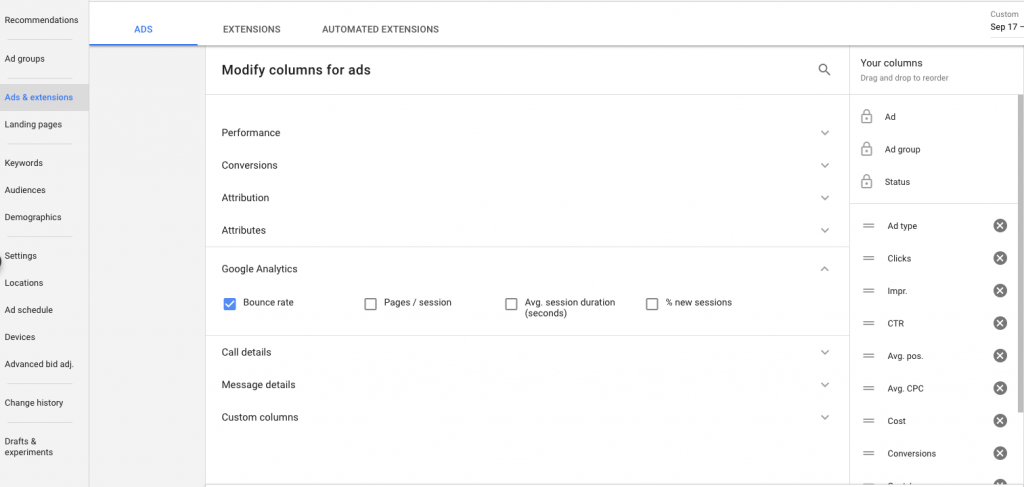
4. Change Match Type for High Average CPC Keywords
There isn’t anything too new about this tip, however it may simply be something that you had never thought to done as it involves using the search terms report slightly differently.
The search terms report is the place to go to find what searches actually triggered your ads. From there you can easily add these keywords to your account if you deem them relevant, or add them as negatives if you don’t. And if you have Broad Match keywords in any of your keyword sets, another use for this report is to sort your search terms by average CPC in descending order. Often you’ll be surprised at the high average cost of some of your broad match keywords, which may only be getting one or two clicks. From there you can either add the keywords as negatives or, if you like them, change the match type to something more specific like Phrase Match and add them to your account that way. For example, one of our agency’s own paid keywords, which is driving traffic to our SEO eBook, broad matched for the rather awkward phrase ‘how to make your website seo optimized’ – at a cost of $9.81 for one single click with no conversion! Needless to say that high cost, low performing keyword phrase is getting added as a negative.
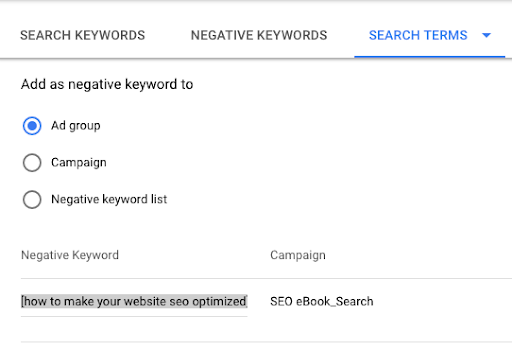
To see these high CPC keywords do the following:
- Click into your keywords and above the graph click Search Terms, then Search Terms from the menu
- Sort by average CPC so that the keywords appear in descending order
- Note your low click, high CPC keywords, which may be broad match. Click the check box next to the keywords and either add them as negatives, if you don’t like them, or click Add as Keyword if you do
- If you’re adding broad match keywords, you can edit the keyword with quotation marks to change the match type to Phrase. You can also eliminate some of the words from the keyword phrase, and even set a max CPC if you felt a little sticker-shock from the price that you paid for the click
- Click Save and you’re done
As always keep an eye on the new keywords you’ve added and make sure they’re performing well. Dial up or down the bids accordingly.
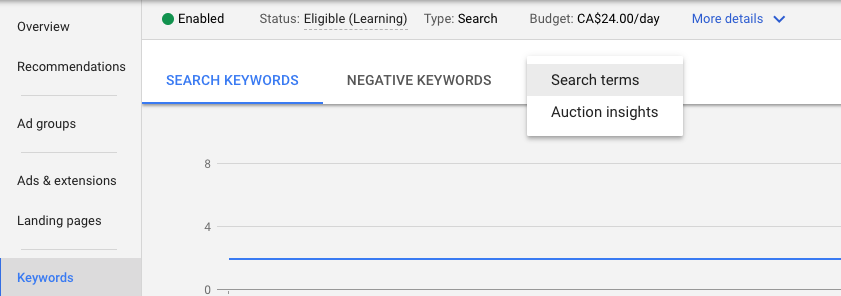
Those are our top four keyword optimization tips for 2018, as discussed with the pros over at Google Ads. If you’ve got any questions leave us a comment, or let us know what your top tricks of the trade are!
Want to Take your Pay Per Click Campaign to the Next Level?
While a DIY mindset is a great way to approach pay per click campaigns, with the digital media industry changing constantly, augmenting your team with knowledgeable experts can makes it easier to outpace your competition. There are a lot of subtle nuances that can make a big difference.
If you need help optimizing your next pay per click campaign, we can help. Request a free PPC audit today.







